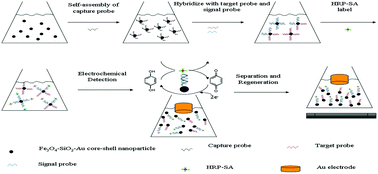Magnetic separation and detection of a cellulase gene using core–shell nanoparticle probes towards a Q-PCR assay
Abstract
A

* Corresponding authors
a
College of Environmental Science and Engineering, Hunan University, Changsha 410082, P. R. China
E-mail:
tanglin@hnu.edu.cn, zgming@hnu.edu.cn
Fax: +86-731-88822778
Tel: +86-731-88822778
b Key Laboratory of Environmental Biology and Pollution Control (Hunan University), Ministry of Education, Changsha 410082, P. R. China
c School of Management Science and Engineering, Guangxi University of Finance and Economics, Nanning 530003, P. R. China
A

 Please wait while we load your content...
Something went wrong. Try again?
Please wait while we load your content...
Something went wrong. Try again?
L. Tang, M. Wu, G. Zeng, J. Yin, Y. Liu, X. Lei, Z. Li, Y. Zhang, J. Zhang and X. Yuan, Anal. Methods, 2012, 4, 2914 DOI: 10.1039/C2AY25087J
To request permission to reproduce material from this article, please go to the Copyright Clearance Center request page.
If you are an author contributing to an RSC publication, you do not need to request permission provided correct acknowledgement is given.
If you are the author of this article, you do not need to request permission to reproduce figures and diagrams provided correct acknowledgement is given. If you want to reproduce the whole article in a third-party publication (excluding your thesis/dissertation for which permission is not required) please go to the Copyright Clearance Center request page.
Read more about how to correctly acknowledge RSC content.
 Fetching data from CrossRef.
Fetching data from CrossRef.
This may take some time to load.
Loading related content
